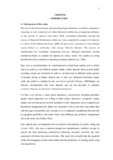Please use this identifier to cite or link to this item:
https://elibrary.tucl.edu.np/handle/123456789/1029| Title: | Determinants of Bank Deposits of Nepalese Commercial Banks |
| Authors: | Maharjan, Laxmi |
| Keywords: | Determinants;Bank Deposits;Commercial Banks |
| Issue Date: | 2018 |
| Publisher: | Central Departmental of Management |
| Abstract: | Deposits are the most secured and liquid financial assets available, which can accelerate bank lending to various sectors. Similarly, bank deposit plays an important role in economic development of country. Deposit serves as the main source of funds for bank intermediation activities which can simply classified as fixed deposit, saving commercial banks. The study is based on secondary data of 20 commercial banks with 140 observations for the period of 2008/09 to 2014/15. Data and information have been collected from Banking and Financial Statistics of NRB and annual reports of the selected commercial banks. The research design adopted in this study is descriptive and causal comparative research design as it deals with the determinants of bank deposits of Nepalese commercial banks.This study attempts to examine the determinants of bank deposits of Nepalese commercial bank. The descriptive statistics for commercial banks shows that the average saving deposit, fixed deposit, current deposit, saving deposit rate, fixed deposit rate, number of branches, return on assets, gross domestic product, population growth rate, money supply and consumer price indexare Rs. 12.88 billion, Rs. 6.65 billion, Rs. 3.79 billion, 2.50%, 4.37%, 50.11 numbers, 1.72%, 4.34%, 1.35%, 18.83% and 9.47% respectively.The regression analysis reveals that saving deposit rate has negative impact on saving deposit. This indicates that higher saving deposit rate, lower would be the saving deposit. However, number of branches has positive impact on bank deposit. This reveals that higher the number of branches, higher would be the bank deposit. On the other hand, return on assets has positive impact on saving deposit and current deposit. This states that higher the return on assets, higher would be the saving deposit and current deposit. The study also shows that consumer price index has negative impact on bank deposit. This reveals that higher the consumer price index, lower would be the bank deposit. Similarly, gross domestic product has negative impact on bank deposit. This states that higher the gross domestic product, lower would be the bank deposit. The study also reveals that saving deposit rate, fixed deposit rate, number of branches, return on assets and consumer price index are major determinants of banks deposit of Nepalese commercial banks. |
| URI: | http://elibrary.tucl.edu.np/handle/123456789/1029 |
| Appears in Collections: | Finance |
Files in This Item:
| File | Description | Size | Format | |
|---|---|---|---|---|
| Cover.pdf | 443.55 kB | Adobe PDF |  View/Open | |
| CHAPTER.pdf | 2.11 MB | Adobe PDF |  View/Open |
Items in DSpace are protected by copyright, with all rights reserved, unless otherwise indicated.
